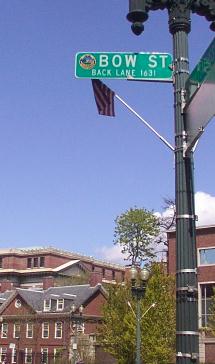
|
|
|
|
Urban Slivers: |
||||
|
|
An
Investigation of the Bow Street / Arrow Street Area - Cambridge,
MA
|
||||
|
|
The previous three projects introduced the neighborhood as a collection of experiences and stories, both human and natural. To conclude, this section introduces and re-introduces themes and stories of various details specific to the site and explores their relationship to urban context at a larger scale.
Signs and Signifiers
One of the most visible extant elements that relates to the history of the site is printed on the street signs. On selected signs, the original name of the street and its date of construction is in smaller letters below the current name of the street. When I first visited the site, I mistook the dates for address numbers; many streets near my home have the first address on the block or coordinate number written in a similar place on the sign.
The placement of historical information on an otherwise banal street sign demonstrates a significant value judgment. Not only has the history been placed in a visually prominent location, but on signs of the same size and color as those deemed "non-historic." There is an implicit difference between street signs that have the historic marking and those at the same intersection that do not; even though the current physical appearance of all the streets in the area is of similar paving, some have been deemed "extra-special." What is fascinating is that even many of the newer streets date from the early nineteenth century and would be considered historic in many other parts of Cambridge or the US for that matter; the sheer age of the Harvard area settlement determines the abnormally old threshold of importance.
The former names on the street signs hint at how Bow Street was the literal "Back Lane" of the area, rather than another interstitial street. The historic naming hints at the age and actual importance of Arrow Street as the direct link to the "neck" of land near Cambridgeport.
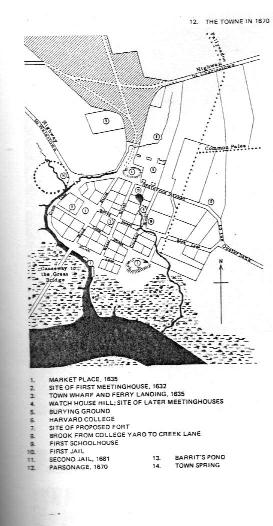
Source: Chalat, 1990 (Illustration of Harvard Square vicinity
c. 1670)
These names were found in the plan of Old Cambridge from c. 1670, but the actual dates on the street signs is somewhat in question. In my research for primary documents on street history, I found a listing of streets and their accepted date of first construction from January 1, 1963. While it lists Arrow Street as founded in 1635, it records a date of 1785 for Bow Street. Thus, the municipal signs may not be thoroughly accurate. Is the 1631 date given on the sign for Bow Street the date of a previous street somewhere in the vicinity? Was the street last modified in 1785? The street sign obviously cannot answer, and the limitations of a historical marker are evident.
The street signs also differ from historical markers and signs placed on historic buildings. They demonstrate a civic importance in the history of the physical space of the street, not just the buildings that face it. This civic, governmental commitment is subtler than a large building with a historical marker, yet it is perhaps more emphatic because it values an importance that transcends the current appearance of the street and reaches towards a larger concept of the street's reality.
The German literary analysis concept of Sein und Schein deals with the disjunction between reality and appearances in character. The Bow and Arrow Street area buildings have aged sufficiently such that many have reaccommodated several major use changes. As Jane Jacobs advocated in Death and Life of Great American Cities, old buildings have an intense appeal towards building neighborhood character and identity. The Reversible Collar Factory building is an example of a trend common nationwide where nineteenth-century industrial production facilities have been converted to flexible space for artists, architects, and other new technologically-oriented businesses. It is a good example of Steward Brand's notion of the manner in which buildings learn to adapt; the current interior layout bears little relation to that of the factory, and the relatively anonymous character of its originally simple brick and timber construction allow the tenants' modifications to add their own visual character. As is the case with the street signs, there is a deliberately placed historical reference, a physical sign that describes the building's history verbally rather than just visually.
The Sein und Schein issue reflects how the building has outlived its economic impetus and that its current appearance as "historic" is now a source of trendiness that draws new types of commercial tenants. The presence of an antique shop in the gabled building adjacent to the factory building shows how the appearance and reality of age in the built environment influence the types of commercial uses that are appropriate and even successful.
Another trend is subverting the appearances and reappropriating space for new uses. Southeast of the vacant lot is a beautifully detailed wood-frame home that has pink clapboards. As this is one of the residential areas closest to Harvard Square, its materials and scale seem significant towards maintenance of a residential context. The glass door at the top of the porch, however, hints at its actual use: the building houses not a family, but a software development company. As businesses begin to penetrate into residential settings, the family-oriented pedestrian life will likely be lost. This is not even the old model of a street-level pedestrian-oriented business with family quarters above; the appearance and the reality of the buildings is becoming quite disparate.
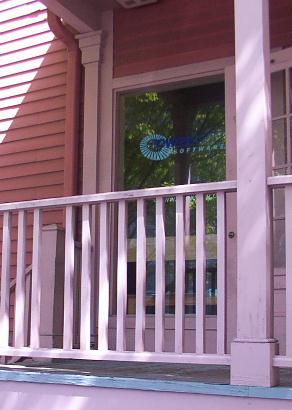
Reading Materials
The brick sidewalks in the vicinity have much the same appearance as brick sidewalks throughout the rest of Cambridge. As discussed with respect to natural processes, the areas with brick set in sand have far greater permeability for drainage and are thus able to support natural life such as trees more readily than concrete foundations and sidewalks. Upon first glance, each of the brick sidewalks seem to be equally quaint and historic. Under closer observation, however, the sidewalks along Massachusetts Avenue are in fact much newer and are brick set in a concrete base, effectively obliterating the hydrologic effectiveness of the system. Only a few areas along Bow and Arrow Streets themselves are brick set in sand, and these seem to be lacking in upkeep as roots meander and displace individual bricks.
This demonstrates a connection to the larger civic context of the site. Cambridge wants to show a historic face to its visitors and inhabitants, but is less concerned with the historic construction techniques of its sidewalks. Therefore, the intermittent sidewalk extensions along Massachusetts Avenue from Central Square up towards the site in the Harvard Square vicinity are pedestrian-friendly but not ecologically effective.
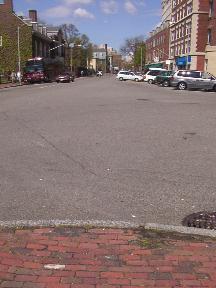
In contrast with the detailed scale of the brick along Bow and Arrow streets, the edges of the site seem bounded by asphalt acreage. The intersection at Bow Street and Mount Auburn Street is particularly generous, far larger than its traffic patterns or use would dictate. Whereas Massachusetts Avenue has sufficient activity to motivate street crossings and pedestrian connections, this area is far less busy and the majority of the pavement is rarely populated by vehicles. Instead, it acts as a visual barrier between portions of Harvard and the rest of the landowners in the area. If the street-level businesses could support a pedestrian environment as active as that on Arrow Street, replacing the asphalt intersection with a mixed-use brick-paved space might create a vibrant new public space.
Between Zero and Nothing
One of the most prominent and visual clues to a story in this neighborhood relates to the large vacant lot. It had been one of the issues that drew my interest in the first project, and while my map investigations and observations seemed to hint at its former use, the history of its demise and current status was not clear.
I chose to research the site and its environs at the Cambridge Historical Commission in Central Square. The office of insightful and helpful researchers helped me find several folders full of paperwork, newspaper articles, and architectural analyses of the buildings that formerly inhabited the space. The currently vacant lot was comprised of four lots in a 2x2 grid, with nineteenth-century home on each. Between the northeasternmost house and the shops on Massachusetts Avenue was an L-shaped garage building being used as a bicycle sales shop. All that remains of it is the partially demolished wall shown in project 3:
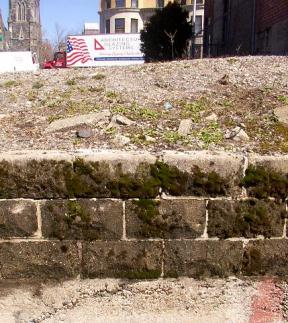
I had guessed that the lack of development on the site was related to industrial waste issues from the garage when I thought it was a service station. Upon further review it appears that while such contamination issues may exist, the use of the site was far more of a commercial than an industrial nature. The reasons for the continued vacancy of the lot require further explanation.
My research shows that the lots were bought out by a developer in the mid-1980s; demolition proceeded until 1988. The Cambridge Historical Commission recommended that the house at 19 Mount Auburn Street be relocated so that it could be preserved as part of the visual character of the neighborhood. While the absence of building is the most tangible aspect of the site alteration, this is a case of a building whose presence reflects the change. The building formerly at 19 Mount Auburn Street was moved in late 1988 to an interstitial site two lots to the east so that the site was finally empty. The relocated house has been placed on a raised foundation above a brick paved courtyard between it and its neighbor houses, some of which appear to be used for commercial office purposes.
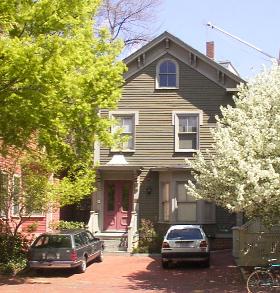
While this was an innovative way of preserving a portion of a neighborhood that is preferable to large-scale clearance, it was clearly not without dissent. I read a letter from Terry Crystal of the East Harvard Square Neighborhood Association, whose terse writing asserts that the building violates zoning and building code in its relocated position. This assertion is rather curious since the zoning boundary is based on the uses of the buildings that were already existing rather than acting as a proposal for the use of a new building inserted between lots. The written argument proceeds with evidence of how close the building is to abutting properties, concluding it should never have been moved and should be removed. Whether the neighborhood association wanted it replaced is unclear, but they had opposed the house destruction from the beginning based on neighbors' rights:
"To violate
their
rights in an attempt to
accommodate the developer
in what appears to be some wrongdoing
would be a great miscarriage of justice."
(Letter dated 25 April 1989, courtesy of Cambridge Historical
Commission.)
An irony is that the building across the street houses, of all institutions, the Harvard Planning and Real Estate Office. Surprisingly, the story of the site with such a prominent view has little to do with Harvard directly.
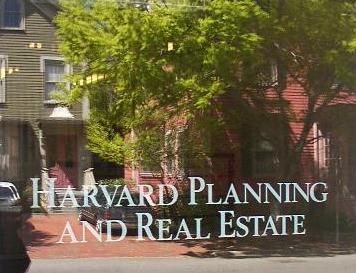
The site is still owned by a developer associated with Graham Gund Architects, but neighborhood opposition has prevented construction from becoming feasible since the proposed building is so voluminous and overbearing. Graham Gund Architects' proposal is a five- to six-story office building with neoclassical (i.e. post-modern, rather than historic) detailing that would loom over the entire site, blocking all sun from reaching Arrow Street. It would include executive parking underground and perhaps one shop at street level, but no major public functions. The one connection to Harvard is purely one of proximity: the developer cites the character of Harvard Square and its environs as a favorable advantage to pitch to prospective tenants. Yet the building's emphatic lack of association with public space and its insensitivity to the neighborhood would have the potential to destroy that which it hopes to benefit from. The success of offices in the former industrial factory building next door points to how buildings that adapt are often more successful than brand new ones supposedly tailored to a particular use.
The shallowness of the development proposal continues to the smallest detail of an address: I sought information to be filed under the addresses of the former houses: 2 Arrow Street, 4 Arrow Street, etc.. I soon discovered that the entire vacant lot and the proposal had been named Zero Arrow Street in an attempt to make it supposedly more prestigious. It was a prescient but unfortunate harbinger of the absence of building that the address should be a cipher as well.
In studying the effects of urban renewal and land clearance of the past half-century, the resulting urban spaces were almost always reappropriated, even if not with particularly appropriate architecture. In the instance of Zero Arrow Street however, the situation was that the houses were in slight disrepair and were unable to avoid being absorbed into commercial real estate. In an attempt to strive for a very large area of rentable (i.e. profitable) space, the plan backfired and the site has been vacant for almost 15 years with no income or neighborhood benefit. It is even restricted to private parking in an area where any sliver of public parking would be savored. This seems an anomalous scheme because of the absolute completeness of the demolition, including cutting large street trees down to stumps, and yet the incompleteness of any progress toward a new use for the site. The status thus remains between zero and nothing. Perhaps the site's most frequent use is that of a site for various urban architecture studios at Harvard's Graduate School of Design and MIT's Department of Architecture.
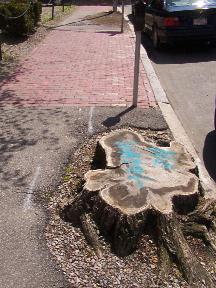
Urban Slivers; Slices of Life
The intimate physical scale of the Bow and Arrow Street neighborhood and the sheer uniqueness of its commercial inhabitants build a strong sense of character and identity to these blocks; this sense is increased by return visits. Places like Cambridge Architectural Books and One Arrow Street Crepes are purposefully unique and are thus a draw to the site in a way that chain stores or large commercial enterprises cannot emulate. The Polish crepe-maker and her fellow restauranteurs recognize me by name each time I visit. The Cafe Pamplona is intrinsically linked to being a slightly out-of-the-way and in a partial basement under the bookstore. Yet these highly personable places are part of my perception as a tourist to the area; a professor who has an architecture office in the Reversible Collar Factory has never been to the creperie across the street, and the creperie workers never thought to find the reason for the vacant lot from which customers' cars get towed. Likewise, my perception is incomplete because I only see a few snapshots, slices of life within a larger continuum of the neighborhood through time.
One of the challenges that the neighborhood faces is one of identity. As Harvard University continues its growth, surrounding areas such as these that do not focus exclusively on institutional buildings have the options of either trying to blend into the scale and style of the surrounding institutions, or instead presenting a contrasting scale of small shops and homes. Bow Street and Arrow Street currently have a strong identity of the latter, but the residential component of the neighborhood seems particularly threatened. Nineteenth century homes in the area now house internet startups and therefore alter the character and patterns of use in the immediate surroundings. The path of the Number One MBTA bus that careens down Bow Street is indicative of the larger and larger vehicular volumes using side street routes to avoid the crowded arteries, but in doing so they interrupt the pedestrian emphasis of the area and create divisions across large asphalt intersections. This is not just a challenge of image in the manner of Lynch, but rather one of identity of use. Will this area remain a hidden void that acts as background to the bustle of Harvard Square proper, or will it be overtaken by the Abercrombie & Fitch-types of brand-name commercial activity? The neighborhood does not need to deal with the creation of an identity, but rather the careful maintenance of an evolving one.
The other major challenge is one of new built elements. The neighborhood association's activeness in the late 1980s did not undo the house relocation, and it has not been visibly able to solve or propose improvements for the Zero Arrow Street property. The association of residential neighbors may even be dwindling and being replaced by an association of business owners as per the first challenge. Moreover, the existing density of the site creates a hostility toward changed or new elements of the built environment. As detailed in project two, the site has had remarkably little change in the past eighty years. The aging wood frame construction of some homes and the need for a remedy at Zero Arrow Street are situations where, sooner or later, new buildings will need to be introduced. A traditional architectural proposal would look at contextualism in terms of what the neighborhood inhabitants remember of previous buildings on the vacant lot, or what the predominant style is on the block, or what consistent uses are within zoning parcels. All of these are nearly irrelevant; my initial conversations revealed that vast confusion over the former buildings, and even a single block can include a church, school, houses, small businesses, converted factory buildings, and large commercial blocks. The area is organic in the sense that its character defies the overt simplicity of large scale zoning. A possible trend for the future is for proposals like the office block for Zero Arrow Street to colonize for commercial and institutional uses, but so many of the building uses are so stable and/or entrenched that relatively small interventions have far greater feasibility than gigantic gestures that work in other parts of Boston and Cambridge.
Spring has now come more fully, and brought even more verdant life to the pocket-size parks and slivers between buildings where plants crane their stems for any light possible. Pedestrian traffic (particularly students) is lively, and the sidewalks seem intimate and friendly, rather than crowded. There has been an increase in visible trash; perhaps this is evidence of spring cleaning, but some of the darker slivers of leftover space and the vacant lot do not seem to get much attention to appearance compared to the manicured lawns of the institutional buildings in view.
The site remains a collage of sharp contrasts and juxtapositions: immaculate lawns and dumpsters, slivers of light and shadow, vacant lots and dense neighborhoods, a scarcity of parking next to a lot on which one should not park, giant institutions and a tiny creperie. It seems curious that in nearly four hundred years a major path along Arrow Street connecting Harvard to the rest of Cambridge has become barely a tiny detail, but it makes it an even more precious privilege to uncover some of the stories latent within the spaces. I would love to learn how the stories of neighborhood inhabitants intertwine with the physical, natural, and architectural history of the area. The neighborhood around Bow and Arrow Streets is one of the few places that presents such a slice of life in the heart of Cambridge, not with civic monuments or grand gestures, but with a perplexing and wonderful combination of uses that is a rarity to be treasured in an American city.
The creperie door closes, shuttering gently.
The Number One bus rumbles past. I just missed it.
The footsteps are becoming more infrequent as the evening turns surprisingly colder, even this late in spring.
The small, dainty bell has stopped ringing; the architectural bookstore has closed, but the stories latent around it remain.
Sources:
Brand, Stewart: How Buildings Learn. (c) 1995 Penguin Books.
Cambridge Editorial Research, Inc.: The Cambridge Book - 1966. Published by the Cambridge Civic Association.
Chalat, Josef Yul: Connections to the City: A Spatial Structure for New Perceptions of Harvard Square. (c) 1990, MIT M.Arch. Thesis.
Emmet, Alan: Cambridge, Massachusetts: The Changing of a Landscape. (c) 1978 by the President and Fellows of Harvard College.
Jacobs, Jane: Death and Life of Great American Cities. (c) 1961 Vintage Books.
Other research from documents in the collection of the Cambridge Historical Commission.
All images (c)
2001-2002
David M. Foxe, unless otherwise notated. All Rights Reserved.
|
|